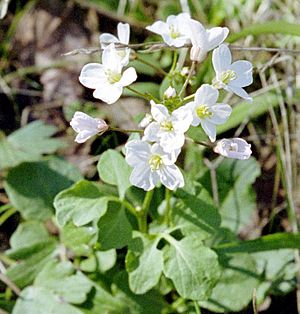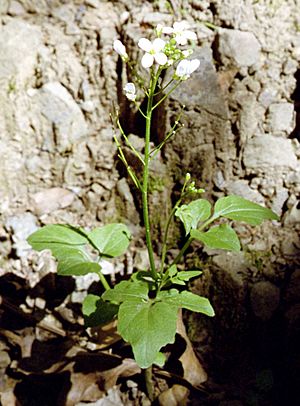Milkmaids facts for kids
Quick facts for kids Milkmaids |
|
|---|---|
 |
|
 |
|
| Scientific classification | |
| Genus: |
Cardamine
|
| Species: |
californica
|
| Synonyms | |
|
Dentaria californica Nutt. |
|
Milkmaids, also known as Cardamine californica, is a pretty flowering plant. It belongs to the Brassicaceae family, which includes plants like cabbage. You can find milkmaids growing naturally in western North America. This includes areas from Washington down to California and Baja California in Mexico.
This plant loves different places like shady hillsides, open forests, and grasslands. It often blooms in winter and early spring. In the San Francisco Bay Area, milkmaids are one of the very first wildflowers to open their blossoms, usually from January to May.
About Milkmaids Plants
Milkmaids are herbaceous plants. This means they have soft stems, not woody ones like trees. They are also perennial plants, which means they live for more than two years. These plants usually grow to be about 1 foot (30 cm) tall.
Milkmaids Flowers
The flowers of the milkmaids plant grow in a cluster called a raceme. Each flower is about 1/2 inch (1.25 cm) wide. They have four petals that can be white or sometimes a light pink color.
These clever flowers close their petals in the late afternoon when the sun starts to go down. They also bend their stems (called pedicels) downwards before it rains. This helps to protect their pollen from getting wet.
How Milkmaids Make Seeds (Reproduction)
Scientists have studied how milkmaids make seeds. In the San Francisco Presidio, they tried helping two groups of milkmaids with hand pollination. Pollination is when pollen is moved from one flower to another, which helps plants make seeds.
Normally, only about 8% of the flowers would make seeds. But with hand pollination, this number jumped to 85%! The seeds then took about 53 days to become ready. This shows how important pollination is for these plants to reproduce.
See also
 In Spanish: Cardamine californica para niños
In Spanish: Cardamine californica para niños

